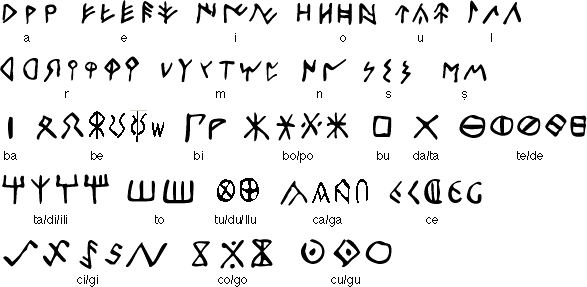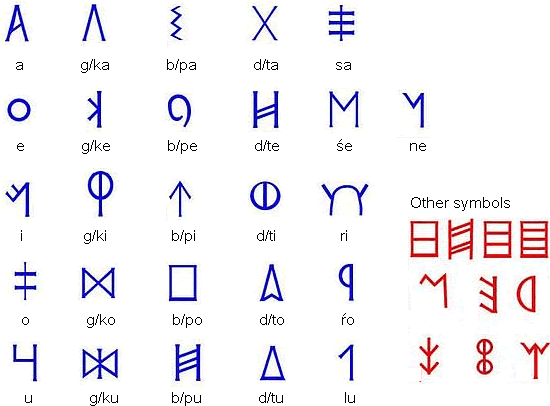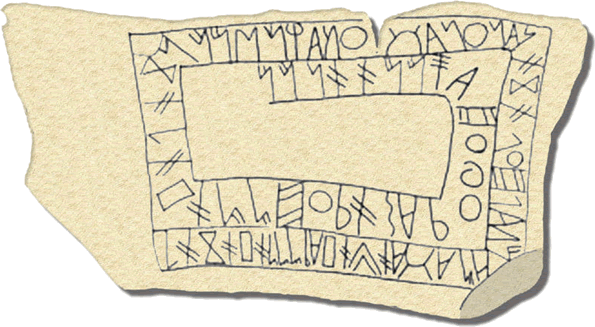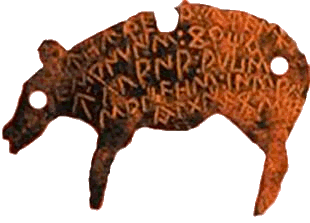Iberian scripts
Many inscriptions in the Iberian scripts have been found on the Iberian peninsula, in southern France and on the Balearic Islands. The oldest known inscriptions date from the 4th century BC. The scripts are thought to have derived from the Punic alphabet.
In the 3rd century BC the Iberian peninsula was invaded first by Carthage, then by the Romans. Thereafter, the Iberian scripts and the languages they were used to write gradually disappeared.
Notable features
- The Iberian script is mainly syllabic but also partly alphabetic.
- There were two version of the Iberian script - one used in southern France, Catalonia and Castile, the other used in Andalusia and Mursia. The main difference between these versions is the shapes of the glyphs and direction in which they were written. The northern version was written from right to left, while the southern version was written from left to right.
Used to write:
Iberian, a non-Indo-European language which has so far resisted decipherment, and Lusitanian, an Indo-European language possibly related to the Celtic languages. A modified version of the Northern Iberian script was used to write Celtiberian, a Celtic language. The most recent inscriptions in these language date from the 2nd century AD and they are thought to have become extinct by then.
Northern Iberian script

Southern Iberian script

Southwest Script
This Southwest Script was used in southwestern Iberia to write an unknown language which is usually identified as Tartessian. A total of 75 inscriptions in this script dating from between the 7th and 5th centuries BC have been found in the Algarve and southern Alentejo in Portugal, and in southern Extremadura and western Andalucia in Spain. The script is also known as the Southwestern Script, the Southwest Paleohispanic script, the Tartessian Script or the South Lusitanian Script.
The Tartessian language, which is also known as Southwestern or South Lusitanian, is an extinct language spoken in the southwestern Iberia. The name Tartessian comes from Tartessos, a city that once stood at mouth of the Guadalquivir River in Andalusia. Tartessian was possibly a Celtic language, though this is uncertain.
Notable features
- Type of writing system: syllabary
- Direction of writing: variable - right to left in horizontal lines, boustrophedon or spiral
- Used to write: Tartessian (?)
A possible southwestern signary

Based on information from Rodríguez Ramos, Jesús (2000): «La lectura de las inscripciones sudlusitano-tartesias»
Sample texts
Northern Iberian Script

Lead plaque from Ullastret [source]
Southern Iberian Script

Lead plaque from La Bastida de les Alcuses (Moixent) [
source]

Fonte Velha (Bensafrim, Lagos) [
source]
Celtiberian
Celtiberian is an extinct Celtic language once spoken on the Iberian peninsula until about the 1st century BC, particularly between the Duero, Tajo, Júcar, Turia and Ebro rivers in the north of what is now Spain.
Celtiberian is thought to have been a Q-Celtic language related to the Gaelic/Goidelic languages of Ireland, Scotland and the Isle of Man. There are Old Irish legends preserved in the Lebor Gabála Érenn (The Book of Invasions) name the Milesians, a people from Iberia, as being the ancestors of the Irish. The Celtiberians themselves are thought the have migrated to Iberia from Gaul (France), perhaps during the 6th century BC.
The name Celtiberi appears in the writing of Roman authors such as Diodorus Siculus, Appian and Martial, who thought these people were a mixture of Celts (Celtae) and Iberians (Iberi), with the Celts being dominant. They also recording the tribal names Arevaci, Belli, Titti and Lusones.
The Celtiberian script developed from the Iberian scripts. About 200 inscriptions in Celtiberian have been found in the Celtiberian alphabet, and also in the Latin alphabet, dating from between the 6th and 1st centuries BC. With the Roman take over of the Iberian peninsula, the Celtiberian script was gradually replaced by the Roman/Latin alphabet and eventually disappeared.
Notable features
- Type of writing system: partly syllabic and partly alphabetic.
- Direction of writing:
- Used mainly by druids for religious purposes
Celtiberian alphabet

Sample text

From Uxama (Western script) [source]
Source:
http://www.omniglot.com/writing/iberian.htm
http://www.omniglot.com/writing/celtiberian.htm






 LinkBack URL
LinkBack URL About LinkBacks
About LinkBacks







 Citar
Citar
Marcadores